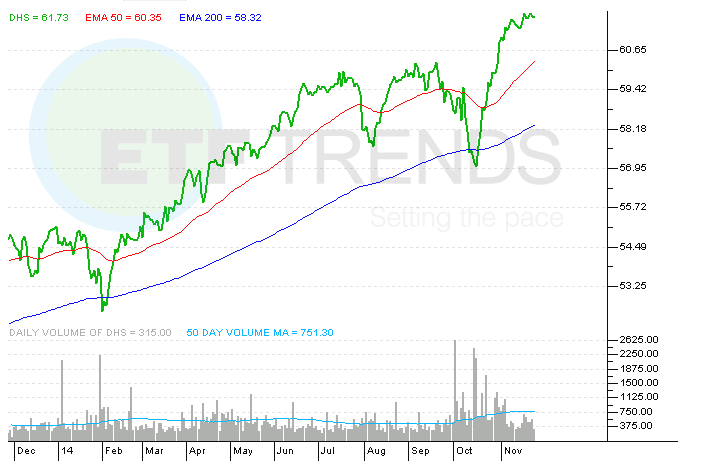Time to Shift to These Dividend ETFs (DGRW) WisdomTree HighYielding Equity Fund ETF (ETF DHS)
Post on: 12 Июль, 2015 No Comment

The specter of rising interest rates has investors pondering the near-term fate of low-beta sectors previously prized for low-risk dividends.
Income investors, and rightfully so, are wondering why they should be involved with capital-intensive utilities if those companies are subject to higher borrowing costs when rates rise. Betting on consumer staples stocks with heavy international exposure when the U.S. dollar is strengthening is another obvious source of concern.
Things have gotten dire quickly for some dividend ETFs as a result. The Wall Street Journal proclaimed as much on Tuesday with the headline The End of the Affair for Dividends .
Still, inflow data from BlackRock indicate $3.7 billion flowed into dividend ETFs last month, bringing the year-to-date total to $14.9 billion. Throw in the $6.9 billion real estate funds and the $3.3 billion that went to preferred stock funds and income oriented ETFs have seen year-to-date inflows of $24.7 billion.
The problem is not inflows to dividend ETFs. Rather, the recent struggles of the utilities sector and the potential for consumer staples to follow suit highlight the need for investors to look beyond the usual dividend ETF suspects. That group was mentioned in the Journal piece and includes ETFs such as the Vanguard Dividend Appreciation ETF (NYSE: VIG ), the Vanguard High Yield Dividend ETF (NYSE: VYM ), the SPDR S&P Dividend ETF (NYSE: SDY ) and the iShares High Dividend Equity ETF (NYSE: HDV ).
Investors love that quartet. Inflows say as much as those four ETFs have attracted a combined $5 billion in new assets this year as of May 31, according to Index Universe data .
Before diving into the nitty gritty, it is important to note that the intent of this piece is not to malign any ETF, its sponsor or its shareholders. The four aforementioned ETFs have delivered solid returns, are all highly liquid and most are reasonably priced.
They are also not the best dividend ETFs in terms of total returns over long-term time horizons. Nor are they the best dividend ETFs for an environment where investors should be searching for new sources of dividend growth at the ETF level.
Just Stop The Bubble Business
Remember, dividend bubble talk is increasing in part because of what investors perceive to be stretched valuations on utilities and staples names. That chatter may prove accurate, but investors have options.
A compelling one is the First Trust NASDAQ Technology Dividend Index Fund (NASDAQ: TDIV ). Obviously, a big part of the equation with dividend investing is dividend growth. That only further highlights TDIV’s utility because tech is now the largest dividend-paying sector in the U.S. with plenty of room for further upside on the dividend growth front.
Did you hear about the May dividend bubble bursting? TDIV did not. In the past month while SDY has traded lower and VIG has gained 0.86 percent, TDIV is up 2.8 percent.
Investors that feel nervous about an all-in bet on the still new concept of technology dividends can consider the newly minted WisdomTree U.S. Dividend Growth Fund (NASDAQ: DGRW ). DGRW does feature a 19.1 percent weight to staples, so income investors are not short-changed on one of their favorite sectors, but the new ETF features no utilities exposure.
DGRW does offer the benefit of an almost 21 percent weight to the technology space and yes, both DGRW and TDIV feature Apple among their top-10 holdings.
Bottom line: The technology sector is becoming a more significant part of the dividend equation, but of the four dividend ETFs highlighted in the Journal piece, HDV is the only one with noteworthy exposure to tech. A 14 percent weight to the sector, but it is almost canceled out in that ETF with nearly the same allocation to utilities stocks. VYM has a 10 percent weight to tech, but that makes it merely that ETF’s sixth-largest sector weight.
Flawed Without Financials

Because ETFs such as VIG and SDY screen possible constituents based on length of dividend increase streaks, financials services is another dividend growth sector that is not prominent in these ETFs. Actually, the better way of saying it is because of the focus on dividend increase streaks, it has hard to find ETFs that offer decent weights to both the financial services and tech sectors.
SDY has a 15.5 percent weight to financials, but just 4.2 percent to tech. HDV gives 14.1 percent to tech, but a scant 1.6 percent to financials. VYM is more appealing with a combined 21.5 percent weight to those two groups, but there are even better options.
Investors keep pouring money into SDY, VIG and VYM because the average three-year return for those ETFs is a stellar 60.4%. It is hard to fathom beating those type of returns, particularly with other dividend ETFs. Hard to imagine, but easy to prove that it is possible.
In no uncertain terms have investors lost out on alpha over the past three years by preferring dividend ETFs that either skimp on financials, tech or both. Here is the proof. The WisdomTree Total Dividend Fund (NYSE: DTD ) has a combined 31.5 percent weight to financials and tech. The sectors are that ETF’s largest and third-largest, respectively.
The WisdomTree Equity Income Fund (NYSE: DHS ) allocates just over 24 percent of its combined weight to those two sectors and hey, utilities and staples combine for almost 28 percent this fund’s weight.
Over the past three years, DTD and DHS have offered an average return of 70.1 percent. Time will tell what the market has in store for DGRW and TDIV, but it is clear that dividend ETFs that investors should start dancing with income ETFs that offer more significant exposure to future sources of dividend growth.
For more on ETFs, click here .
2015 Benzinga.com. Benzinga does not provide investment advice. All rights reserved.














